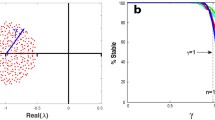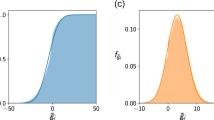Abstract
We review the history and recent progress of the analytical theories of a random community models. In particular, we focus on a global stability analysis of replicator equations with random interactions and species abundance distributions based on statistical mechanics.
Similar content being viewed by others
References
Akin E, Losert V (1984) Evolutionary dynamics of zero-sum games. J Math Biol 20:231–258
Allesina S, Tang S (2015) The stability–complexity relationship at age 40: a random matrix perspective. Popul Ecol. doi:10.1007/s10144-014-0471-0
Bazzaz FA (1975) Plant species diversity in oldfield successional ecosystems in southern Illinois. Ecology 56:485–488
Challet D, Marsili M, Zhang Y-C (2005) Minority games. Oxford University Press, New York
Chawanya T (1995) A new type of irregular motion in a class of game dynamics systems. Prog Theor Phys 94:163–179
Chawanya T (1996) Infinitely many attractors in game dynamics systems. Prog Theor Phys 95:679–684
Chawanya T, Tokita K (2002) Large-dimensional replicator equations with antisymmetric random interactions. J Phys Soc Jpn 71:429–431
Coolen ACC (2005) The mathematical theory of minority games. Oxford University Press, New York
Crisanti A, Paladin G, Vulpiani A (1993) Products of random matrices. Springer, Berlin
de Oliveira VM, Fontanari JF (2000) Random replicators with high-order interactions. Phys Rev Lett 85:4984–4987
de Oliveira VM, Fontanari JF (2001) Extinctions in the random replicator model. Phys Rev E 64:051911
de Oliveira VM, Fontanari JF (2002) Complementarity and diversity in a soluble model ecosystem. Phys Rev Lett 89:148101
Diederich S, Opper M (1989) Replicators with random interactions: a solvable model. Phys Rev A 39:4333–4336
Drossel B, McKane AJ, Quince C (2004) The impact of nonlinear functional responses on the long-term evolution of food web structure. J Theor Biol 229:539–548
Düring A, Coolen ACC, Sherrington D (1998) Phase diagram and storage capacity of sequence processing neural networks. J Phys A Math Gen 31:8607–8621
Eigen M, Schuster P (1979) The hypercycle—a principle of natural self-organization. Springer, Berlin
Elton CS (1958) The ecology of invasion by animals and plants. Mathuen, London
Galla T (2005) Dynamics of random replicators with hebbian interactions. J Stat Mech, P11005
Galla T (2006) Random replicators with asymmetric couplings. J Phys A Math Gen 39:3853–3869
Gardner E, Derrida B, Mottishaw P (1987) Zero temperature parallel dynamics for infinite range spin glasses and neural networks. J Physique 48:741–755
Gardner MR, Ashby WR (1970) Connectance of large dynamic (cybernetic) systems—critical values for stability. Nature 228:784
Gilpin ME (1979) Spiral chaos in a predator–prey model. Am Nat 113:306–308
Hofbauer J, Sigmund K (1988) The theory of evolution and dynamical systems. Cambridge, Cambridge
Hubbell SP (2001) The unified neutral theory of biodiversity and biogeography. Princeton, Princeton
Katayama K, Horiguchi T (2001) Sequence processing neural network with a non-monotonic transfer function. J Phys Soc Jpn 70:1300–1314
Komarova NL (2004) Replicator–mutator equation, universality property and population dynamics of learning. J Thoer Biol 230:227–239
Kondoh M (2003) Foraging adaptation and the relationship between food web complexity and stability. Science 299:1388–1391
MacArthur RH (1955) Fluctuations of animal populations, and a measure of community stability. Ecology 36:533–536
May RM (1972) Will a large complex system be stable? Nature 238:413–414
May RM (1975) Patterns of species abundance and diversity. In: Cody ML, Diamond JM (eds) Ecology and evolution of communities. Cambridge, Belknap
May RM, Leonard W (1975) Nonlinear aspects of competition between three species. Siam J Appl Math 29:243–252
McCann KS (2000) The diversity–stability debate. Nature 405:228–233
McKane AJ (2004) Evolving complex food webs. Eur Phys J B 38:287–295
McKane AJ, Drossel B (2005) Models of food web evolution. In: Pascual M, Dunne J (eds) Ecological networks: from structure to dynamics in food webs. Oxford, New York
Mezard M, Parisi G, Virasoro A (1987) Spin glass theory and beyond. World Scientific, Singapore
Mimura K, Kawamura M, Okada M (2004) The path-integral analysis of an associative memory model storing an inifinite number of finite limit cycles. J Phys A Math Gen 37:6437–6454
Motomura I (1932) On the statistical treatment of communities. Zool Magazine 44:379–383 (Japanese)
Nee S, Harvey PH, May RM (1991) Lifting the veil on abundance patterns. Proc R Soc Lond B 243:161–163
Neutel AM, Heesterbeek JAP, de Ruiter PC (2002) Stability in real food webs: weak links in long loops. Science 296:1120–1123
Nishimori H (2001) Statistical physics of spin glasses and information processing: an introduction. Oxford, New York
Nowak MA, Komarova NL, Niyogi P (2002) Computational and evolutionary aspects of language. Nature 417:611–617
Nowak MA, Sasaki A, Taylor C, Fudenberg D (2004) Emergence of cooperation and evolutionary stability in finite populations. Nature 428:646–650
Opper M, Diederich S (1992) Phase transition and 1/f noise in a game dynamical model. Phys Rev Lett 69:1616–1619
Rieger H (1989) Solvable model of a complex ecosystem with randomly interacting species. J Phys A 22:3447–3460
Rieger H, Schreckenberg M, Zittartz J (1988) Glauber dynamics of neural network models. J Phys A Math Gen 21:L263–L267
Sherrington D, Kirkpatrick S (1975) Solvable model of a spin-glass. Phys Rev Lett 35:1792–1796
Simpson EH (1949) Measurement of diversity. Nature 163:688–688
Sommers HJ, Crisanti A, Sompolinsky H, Stein Y (1988) Spectrum of large random asymmetric matrices. Phys Rev Lett 60:1895–1898
Taylor C, Fudenberg D, Sasaki A, Nowak MA (2004) Evolutionary game dynamics in finite populations. Bull Math Biol 66:1621–1644
Tokita K (2004) Species abundance patterns in complex evolutionary dynamics. Phys Rev Lett 93:178102
Tokita K (2006) Statistical mechanics of relative species abundance. Ecol Inform 1:315–324
Tokita K, Yasutomi A (2003) Emergence of a complex and stable ecosystem in replicator equations with extinction and mutation. Theor Popul Biol 63:131–146
Vandermeer JH (1969) The competitive structure of communities: an experimental approach with protozoa. Ecology 50:362–371
Whittaker RH (1970) Communities and ecosystems. Macmillan, New York
Wigner EP (1958) On the distribution of the roots of certain symmetric matrices. Ann Math 67:325–328
Wootton JT, Emmerson M (2005) Measurement of interaction strength in nature. Ann Rev Ecol Evol Syst 36:419–444
Yoshino Y, Galla T, Tokita K (2007) Statistical mechanics and stability of a model eco-system. J Stat Mech, P09003
Yoshino Y, Galla T, Tokita K (2008) Rank abundance relations in evolutionary dynamics of random replicators. Phys Rev E 78:031924
Acknowledgments
The author thank Tsuyoshi Chawanya, Haruyuki Irie, Tobias Galla, Yoshimi Yoshino, Masanori Sugiura, Tomoyuki Obuchi and Takeshi Oura for illuminating discussions. The present work was supported in part by Global COE Program (Core Research and Engineering of Advanced Materials, Interdisciplinary Education Center for Materials Science), MEXT, Japan, and was also supported in part by the initiative-based project "Creation and Sustainable Governance of New Commons through Formation of Integrated Local Environmental Knowledge", Research Institute for Humanity and Nature (RIHN). The author also acknowledges support by grants-in-aid from MEXT, Japan (Grants No.24570099).
Author information
Authors and Affiliations
Corresponding author
Additional information
This manuscript was submitted for the special feature based on a symposium in Osaka, Japan, held on 12 October 2013.
Appendix
Appendix
Informations on equilibrium states of dynamics of Eq. 20 at \(t\rightarrow \infty\) is derived from the generating functional
where \(\overline{(\cdots )}\) is same as the random average in Eq. 9 over Gaussian distribution of \(a_{ij}\) and a function \(\psi _i(t)\) is another perturbation field introduced for further calculations such as \(h(t)\) in Eq. 20. The function \(\bar{f}(t)\) denotes the average fitness in Eq. 20. The function \(p_0(x_i(0))\) denotes a distribution of an initial state of the population \(x(0)\) of species \(i\) (initial SAD). Important functions such as the correlation function \(C(t,t')\) and the response function \(G(t,t')\) are given by variation
where \(\langle \cdots \rangle\) denotes an average over all trajectories of \(x_i(t)\) (a path integral \(\int D\varvec{x}\) in Eq. 25).
We do not enter into the detailed mathematics here, as they have been reported in depth in the literature (Opper and Diederich 1992; Galla 2006; Yoshino et al. 2008). After the random average of \(Z[\varvec{\psi }]\) and the calculation of the path integral using the saddle point method, the system is found to be described by an effective single-species process with time delay (a multiplicative Gaussian stochastic process)
This process is non-Markovian, and is subject to colored Gaussian noise \(\eta (t)\), with temporal correlations given by
Using this effective process, the correlation function and the response function are to be determined self-consistently as
where \(\langle \cdots \rangle _e\) denotes an average over trajectories of the effective stochastic process of Eq. 28.
The analysis proceeds by making a fixed point ansatz \(x(t)=x, h(t)=h\) in the effective process, leading to
Furthermore we assume time-translation invariance of the response
finite integrated response and no long-term memory
Within the fixed-point ansatz we also assume that each realization of the single-species noise \(\{\eta (t)\}\) approaches a time-independent value asymptotically, which is then a Gaussian variable with zero mean and variance
Fixed points of Eq. 28 then fulfill the condition
where \(z\equiv \eta /\sqrt{q}\) is a standard Gaussian variable. The above algebraic equation has an "extinct" solution \(x(z)=0\) for all realizations of the random variable \(z\) and "non-extinct" solution
with the step function (\(\Theta [x] =1\,\text{ for }\, x>0\,\text{ and }\, \Theta [x]=0\,\text{ for }\, x\le 0\)). Whenever the non-extinct solution exists, the extinct solution is unstable, and finally the following self-consistent equations of the variables \(\{q, \chi , \bar{f}\}\) ("order parameters") can then be derived for the two external parameters: productivity \(u\) and the level of symmetry \(\gamma\)
where \({\mathrm{D}}z\equiv({\mathrm{d}}z/\sqrt{2\pi })\exp (-z^2/2)\) denotes the standard Guassian measure. In the case of symmetric interactions (\(\gamma =1\)) the above equations are same as the result obtained by the different analysis for the symmetric random community model. The set of integral equations Eqs. 37–39 is, in general, not analytically solvable except for special values of parameters \(u\) and \(\gamma\) and is solved numerically, which is much easier than direct simulations of REs.
If we define the survival function \(\alpha _{u,\gamma }(x)\) in the same way as \(\alpha _u(x)\) in the symmetric random community model which is the probability that population of an arbitrary species takes a value larger than \(x\), it is found to equal the probability that a standard Gaussian variable takes smaller value than \(z(x)=\Delta -(u-\gamma \chi )x/\sqrt{q}\) given by Eq. 36 as
and the diversity is given by
which is the same as \(\alpha _u(0)\) of the symmetric random community model if \(\gamma\) is set to \(1\).
Phase diagram of the random community model. The horizontal axis denotes the level of symmetry \(\gamma\) of the inter-species interactions and the vertical axis denotes the strength of the intraspecific competition \(u\). A–C corresponds to the fully antisymmetric case (Chawanya and Tokita 2002), the stable–unstable transition point obtained by the linear stability analysis (May 1972) and the so-called spin glass transition point (Mezard et al. 1987), respectively
Rights and permissions
About this article
Cite this article
Tokita, K. Analytical theory of species abundance distributions of a random community model. Popul Ecol 57, 53–62 (2015). https://doi.org/10.1007/s10144-014-0476-8
Received:
Accepted:
Published:
Issue Date:
DOI: https://doi.org/10.1007/s10144-014-0476-8





